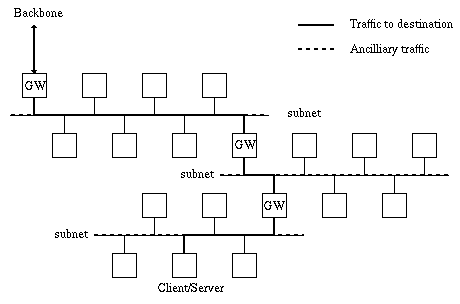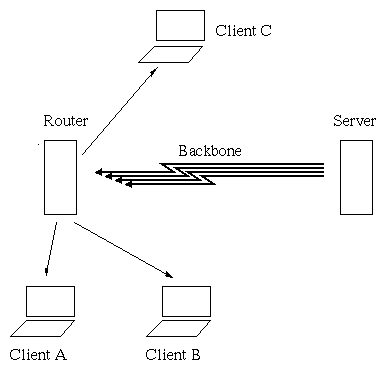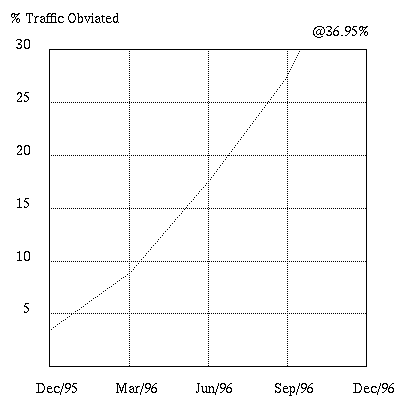 - Daniel M. Germán
- Daniel M. Germán

Alejandro López-Ortiz
 - Daniel M. Germán
- Daniel M. Germán

We propose a caching protocol designed to automatically mirror heavily accessed WWW pages in a distributed and temporal fashion. The proposed caching mechanism differs from proxy type mechanisms in that it caches according to load pattern at the server side, instead of access patterns at the client-side LAN, in a Demand-based Document Dissemination (DDD) system fashion. This type of server initiated caching scheme has been termed push-caching. As well, the proposed caching scheme incorporates topological caching functions. The proposed protocol is orthogonal to other extensions to the HTTP protocol and other caching schemes already in use.
The Net has been identified as a great resource for the dissemination of information: a printing press on everybody's hands. Ironically, the more popular a personal site is, the likelier it is to be discontinued, due to server load. Only large commercial operators can meet the computing requirements of a frequently accessed site. Distributed methods of information broadcast, such as a posting to an Usenet newsgroup or a radio broadcast have a fix set of demands on the broadcaster which is independent of the number of people who actually read or listen to the information distributed. On the other hand, other protocols such as WWW and cable TV require additional investment for every new user. In the latter case, costs are simply passed on to the consumer. But as the WWW is based on the free distribution of information, similar cost recovery schemes are not equally feasible.
As well, transmition of information is highly redundant say, as opposed to Usenet. While a posting to a newsgroup essentially travels any given part of the network but once, a WWW page accessed by two users from the same organization at the same time generates two independent transmissions [Gwe94, Gwe95]. This duplication of broadcast is not unlike that generated by FTP. Indeed, the Alex caching scheme [Cat92] was designed to alleviate these problems while at the same time providing a more familiar user interface to FTP transmissions. As FTP traffic has not increased rapidly enough to be a threat to network bandwidth, Alex has remained subutilized in spite of its clear benefits. On the other hand, traffic on the WWW is fast reaching the critical point of saturation.
To this regard, the National Science Foundation deemed as a critical research topic for the National Information Infrastructure to ``develop new technologies for organizing cache memories and other buffering schemes to alleviate memory and network latency and increase bandwidth'' (in [NSF94] as quoted in [Bes95]).
Because of these considerations several research groups are studying the impact on traffic by proxy/cache additions to the HTTP protocol. It has been shown that the addition of organization edge proxies for incoming traffic, as well as remote cache servers, would result in a noticeable reduction in expected traffic [Bes95].
Currently, some popular browsers, such as Netscape, and some large organizations, such as DEC [Jon94], provide some degree of local caching for their users. As traditionally configured, Netscape retains the last few images and text files accessed in a cache directory which is accessible only to the requestor. This results in a reduction of network traffic and latency. Load in the server, however, is only marginally reduced as the cache is accessible to one user alone. Similarly, the internal DEC network is equipped with a caching relay for the organization (not unlike that of Netscape) to which all internal user requests are first directed. If a hit occurs, the information is served to the user, else the relay host forwards the request to the actual server indicated by the URL. Again, the impact on server load is minor.
At this time, there are proposed modifications to the HTTP protocol, currently implemented in several HTTP servers, that make caching possible for pages which are frequently modified. This new command in the protocol, called ``if-modified-since'' allows a caching client, the so-called proxies, to verify if a cached document has been recently modified. If so, it requests a fresh version of it, otherwise it serves it locally to the user, without generating additional external traffic.
In early August 1994, we started tracing access patterns at a local Web server, and by late October 1994, our measurements confirmed the observations stated in [CBP94]. Thus it became clear that a form of server initiated caching would eventually be necessary. The last fourteen months have, if anything, exceeded our expectations, and more than justify the requirement of server-side caching. However, at this time, there seems to be little work on this area, and none whatsoever at the level of HTTP specifications.
In this work we present a push-caching scheme which, as opposed to [Gwe95], is additional to current client-side proxying schemes.
We propose a collection of collaborative proxies that cooperate in caching of WWW documents. The protocol is designed to implement a Demand-based Document Dissemination system or DDD (as proposed by [Bes95]), meaning that the request for caching is issued by the server depending on local load and size statistics. Among the advantages of a DDD system are that automatic mirroring is provided as well as the efficient use of resources, since documents are cached according to demand and geographic proximity.
A significant difference with other caching schemes is that in this multicollaborative system, caching is initiated by the server. As the server is aware of the modification frequency of a document (say by verifying the last modified date), it avoids many of the problems posed by ``mutable'' documents in [Bes95] by means of not caching highly mutable documents. (Mutable documents are those which are frequently ``updated''.) As well, this scheme partially implements the ideas of geographic and topological caching.
In section 2, we define the different types of traffic generated by Web accesses. Section 3 describes the caching scheme and discusses specific issues of its implementation. In section 4 we describe the results of computer modelling of the caching scheme.
LAN External Traffic is generated by external users accessing locally maintained documents in different internal hosts. Thus, if in the local network configuration the server host A is connected to a host B which in turn is connected to the external Internet gateway server C, each access to a document in A causes network traffic to be increased locally between A, B and C; which in most cases entail a degradation in transmission speed for local users connected to the subnetworks A-B and B-C.
LAN Internal Traffic are local users repeatedly accessing, across an organization's internal network, an internal or external WWW document. Once again, traffic will be increased on the local subnetworks that contain gateways connecting the client host to the server host.
WAN Single Source Traffic is generated by users from the same first or second level domain, such as a country or organization, accessing the same WWW page. In this case we have an international or backbone wire carrying several copies of the same page within relatively short spans of time (see figure 2).
WAN Multi Source Traffic occurs when a popular WWW page is widely accessed across the globe in such a way that no individual organization generates a significant percentage of the traffic, while at the same time, traffic is high enough to bring the server to a halt. In this case, the main objective is to reduce server load rather than network load.

In the case of figure 1, we see that a client requesting a document generates LAN Internal Traffic that could be avoided by proxying in an internal gateway such as with CERN proxy, or by browser caching, such as the one used by Netscape. These two schemes, depending on the specific page being accessed, may also reduce WAN Single and Multi Source Traffic.
The same computer, serving a document generates LAN External Traffic which can be avoided by means of server side caching at the gateway between the LAN and the backbone or better, even further down, if a cache is known to exist closer to the client.

The server only forwards clients to caching servers which are known to hold fresh copies. At the caching side, copies are held as long as indicated in a header of each file served or until the space is needed, whichever occurs first. As the server knows the vital statistics of each file (such as size, last modification date, and access frequency, and in some instances the expiry date of a document), it can automatically place a expiry date derived from these figures using a formula of the form
Expiry Date = (Today)+(Frequency of Accesses)+(Time since last change) +(Size);
where each of the terms might be weighted in an appropriate form.
The proposed protocol is somewhat akin to proxies, most of which have been investigated in terms of physical proximity be it in LANs or slightly wider geographical areas [Bes95, Gwe94, Gwe95]. To our knowledge, none of this proposals have gone beyond a detailed description of the problem. However, those studies provide valuable data for the design of a caching protocol.
The caching scheme works as follows:
slip26.ISP.net% telnet daisy.uwaterloo.ca 80 GET /~alopez-/test.html HTTP/N.N push-caching-proxy PCP.ISP.netThe server then serves the document to the caching proxy which in turn serves it to the client.
Otherwise, the server redirects the client to a push-caching-proxy that has a current copy of the information, according to the server's own local tables. It then replies to the original request with the URL of such caching-proxy. The procedure of choosing the caching-proxy can involve parameters such as heuristic physical proximity of the proxy selected to the client. A possible format for the caching redirection is to reply with an URL, say,
HTTP/N.N 305 Push Cached Content-type: command Location: http://PCP.ISP.net/cachedir/daisy.uwaterloo.ca/~alopez-/test.html
306 Cached file has been removed
Details. Since hyperdocuments are normally composed of text and images, the whole collection of files that compose the hyperdocument can be cached at the same time; hence, only one request to the original server will be necessary, on the behalf that the proxy will contain a valid copy of all the files. The client then will query the proxy for all required files before going to the main server.
Advantages.
Drawbacks. As the server can use local time and size statistics, the server can ensure that small or lightly accessed documents are not cached, thus resulting in no increase of traffic. To our knowledge the only drawback is that all clients should ideally become potential cache servers, which increases the complexity of software on the client side.
Most of the current caching research has concentrated on the
client side. However, in big organizations, with many WWW servers
 significant traffic is generated in the local network while serving
external requests. This traffic, termed LAN External Traffic, may
become a significant percentage of the traffic broadcasted over the
local network.
significant traffic is generated in the local network while serving
external requests. This traffic, termed LAN External Traffic, may
become a significant percentage of the traffic broadcasted over the
local network.
The cache proposed in the previous section provides a natural solution to this problem. Within an organization, a server on the boundary of the local network may cache often accessed documents as requested by the server. When an external hit occurs, the server forwards the request to the boundary server thus obviating the need for internal traffic. The set of documents maintained in the external host changes dynamically as well. In principle, all of LAN External Traffic can be avoided by means of a boundary caching server. As studies show that a 70-80% of traffic is generated by accesses to a few documents [Bes95, Gwe95] it is possible to reduce LAN External Traffic loads by that amount with relatively little additional investment. As the popularity of the Web continues to grow, it is expected that the percentage of savings as part of the total traffic (external or otherwise) will also increase.
Because daisy's connection to the backbone is relatively fast, the number of requests is not altered by traffic load. This might skew some of the statistics when we assume that the same log was created under a slower connection. For one, often a second request occurs close to the first one, which would not be possible if the first file is being slowly transmitted. Secondly, users tend to browse more pages on fast sites than on slow ones.
On the other hand, if the caching protocol proposed is implemented, users would experience reduced latency and thus demand pages in a pattern similar to the one registered on daisy's logs which compensates some of the high traffic patterns registered.
However, the amount of traffic on the Web has been estimated to double every 11 to 16 weeks. At this rate of growth the benefits of Demand Based Caching will become non-negligible in March 96, significant by mid June, and almost a necessity by the end of next year (see figure 3).

Within a year, even sites supporting 500kbs with a maximum 30% network load devoted to Web traffic would benefit from nonnegligible reductions under this demand based caching scheme.
Notice also that this scheme allows for servers inside a LAN to refer all requests to a proxy in the same network acting as gateway between the LAN and the external Internet connection. This has the effect of eliminating LAN External Traffic almost on its entirety (initial requests are still served locally).
In these simulations, when a document is requested, the server uses the IP address to determine if the document has been recently requested by a computer on the same network as the current requestor.

If so, the server forwards the request to that machine which serves the request. If not, the document is served, and the cache tables are updated to reflect the caching of the document on the local caching proxy indicated by the client. Cached documents are assumed to decay with time. We assumed three different half-lifespans for cached documents of 26, 48 and 60 hours. The reduction in traffic in the first case was 12.62%, in the second 14.06% and on the third 14.85%.
Most important is the fact that the savings were reflected not only in the local server load, but also across the network as requests were forwarded to a nearer server to the client.
Thus geographic caching reduces WAN Internal and External Traffic, as well as LAN External Traffic.